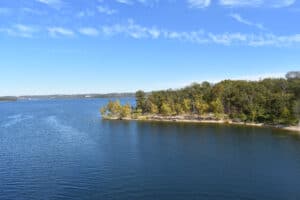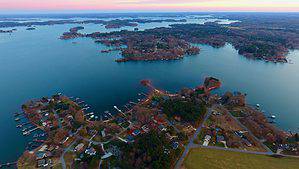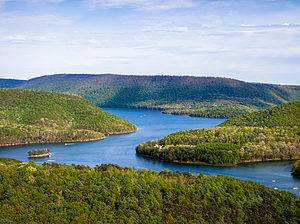Louisiana is full of truly amazing and unique lakes, many surrounded by rich and diverse wetland habitats. The lakes provide a home to monster sunfish and catfish, a plethora of crappie, and even purported Bigfoot sightings! Many of the lakes in the state are actually wetlands, marshes, lagoons, and other very interesting environments making for an exciting lake-going experience.
From Lake Maurepas’ undeveloped laid-back atmosphere to Lake Pontchartrain, the state’s largest lake, there is a lake experience for everyone in Louisiana. State visitors explore Calcasieu Lake to view a rare pink dolphin named Pinky and anglers take advantage of Lac des Allemands, the “Catfish Capital of the Universe.”
Caddo Lake and Black Lake, also called Clear Lake, are great destinations for anglers. In addition to the great fishing presented by Louisiana’s lakes, birds and other wildlife are richly dispersed across the diverse landscapes of Calcasieu Lake and Catahoula Lake. Nearly all the lakes in the state offer excellent boating and primitive camping options directly at the water or nearby.
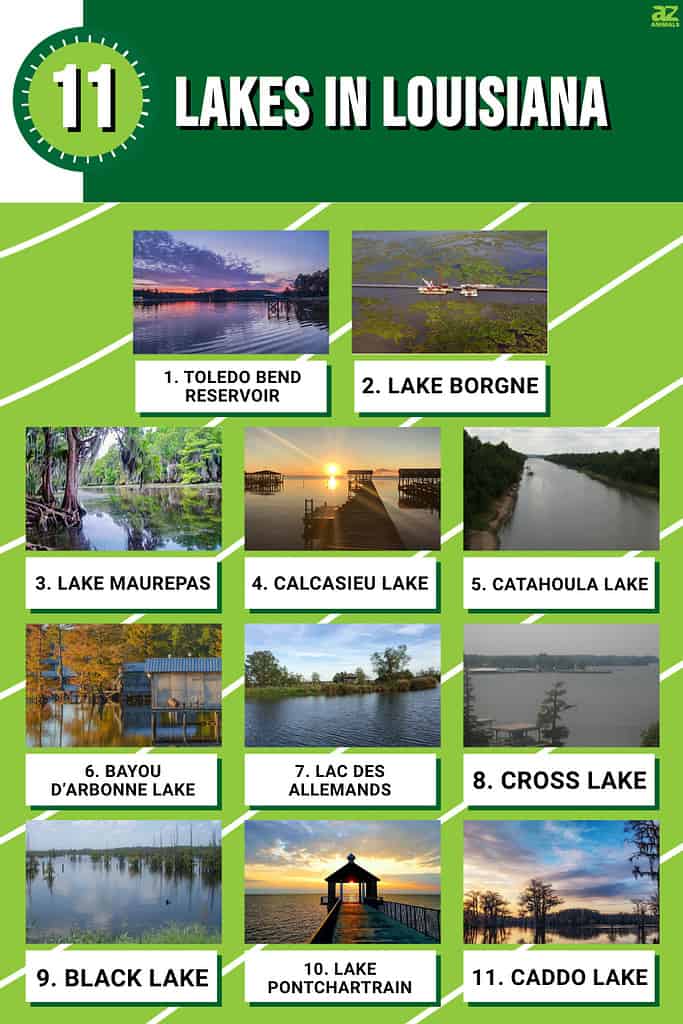
1. Toledo Bend Reservoir
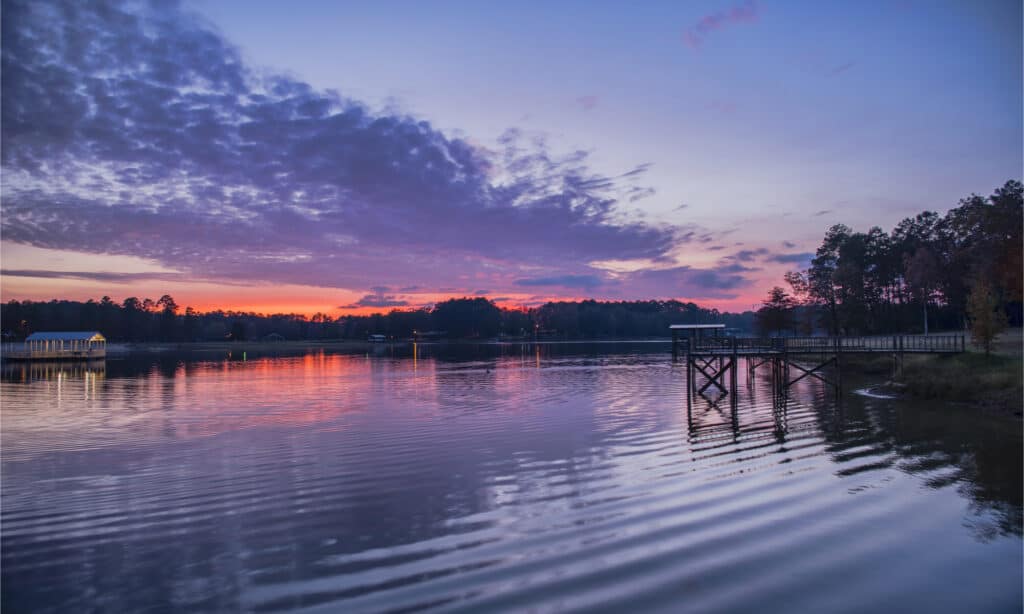
Toledo Bend Reservoir is located along the western border of Louisiana and known to be home to huge sunfish!
©Bonnie Taylor Barry/Shutterstock.com
- Surface Area: 185,000 acres
- Max Depth: 110 feet
- Camping/Overnight Available: Yes
- Boating/Docks Available: Yes
- Swimming Permitted: Yes
- Fishing Permitted: Yes
- Best For: Huge Sunfish, Largemouth Bass, Largest Man-Made Lake In the South
Toledo Bend Reservoir is located on the western edge of Louisiana with parts reaching over into Texas. The reservoir’s creation helps with flood control, power generation, drinking water, and recreation. It’s part of the Sabine River and is the fifth-largest reservoir by surface acre in the United States.
Anglers love Toledo Bend Reservoir for the great crappie, catfish, and largemouth bass fishing. The reservoir also boasts of gigantic sunfish and a 1,200-mile shoreline providing ample places to toss a line.
Camping options and boat ramps are plentiful! Boaters need to act with caution in the water due to the many trees found below the surface. Birdwatchers will see a wide range of species including ducks, geese, common goldeneye, greater scaup, lesser scaup, ring-necked duck, American coot, pied-billed grebe, and black and surf scoters.
2. Lake Borgne
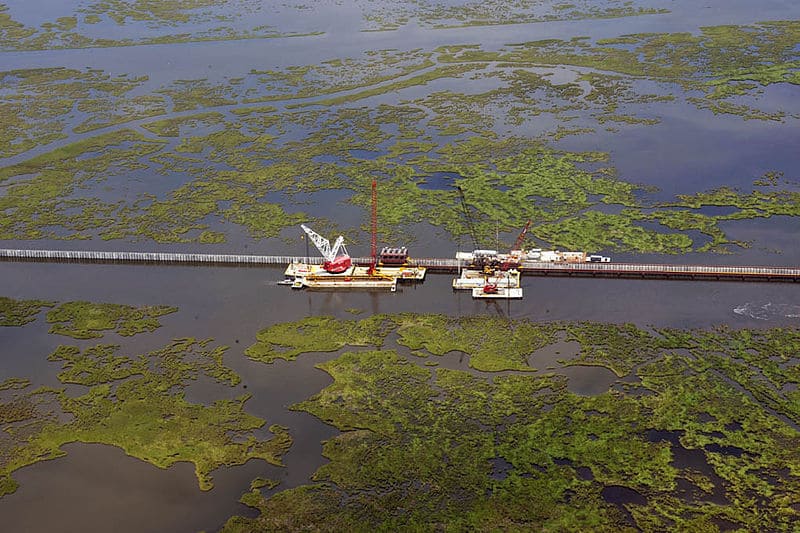
Lake Borgne isn’t really a lake at all, it’s a brackish lagoon that’s an arm of the Gulf of Mexico.
©eutrophication&hypoxia / flickr – License
- Surface Area: 180,400 acres
- Max Depth: 9 feet
- Camping/Overnight Available: No
- Boating/Docks Available: Yes
- Swimming Permitted: No
- Fishing Permitted: Yes
- Best For: Battle of Lake Borgne, Spotted Seatrout, Diverse Wildlife
Lake Borgne is located in southeastern Louisiana close to the Mississippi border. It’s a unique body of water, once a fully enclosed freshwater lagoon. Through coastal erosion, the lake became an arm of the Gulf of Mexico.
The brackish water in Lake Borgne supports both salt and freshwater fish species. Some of the common catches reported by anglers include red drum, spotted seatrout, black drum, bream, catfish, flounder, striped mullet, gulf menhaden, bay anchovy, and sheepshead. Don’t just show up to fish! Get your traps out and taste some of the blue crab, brown shrimp, white shrimp, and oyster plentiful in these waters.
The wetland and marsh areas support many types of wildlife from brown pelican to nutria. You may see brackish-water clam, red swamp crayfish, muskrat, leatherback sea turtle, peregrine falcon, willet, red knot, spotted sandpiper, wood duck, bufflehead, northern shoveler, white-fronted goose, white ibis, snowy egret, and great blue heron while out on the lake’s water. Lake Borgne holds a place in history as the single biggest mistake of the Louisiana portion of the War of 1812, granting enemy soldiers access to U.S. soil.
3. Lake Maurepas
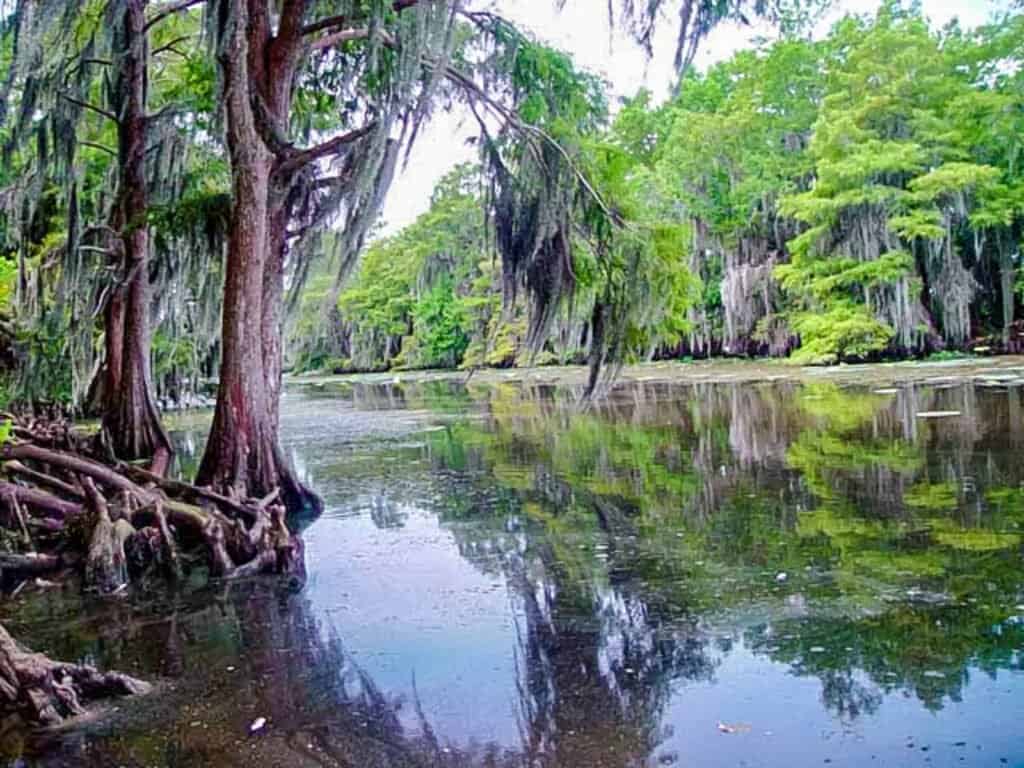
Lake Maurepas is the second-largest lake located entirely in Louisiana known for a laid-back, undeveloped atmosphere and environment.
©iStock.com/undefined undefined
- Surface Area: 59,310 acres
- Max Depth: 9 feet
- Camping/Overnight Available: No
- Boating/Docks Available: Yes
- Swimming Permitted: Yes
- Fishing Permitted: Yes
- Best For: Second Largest Lake Completely In Louisiana, Undeveloped Shoreline, Bass & Crappie Fishing, Hidden Gem
Lake Maurepas is located in south-central Louisiana on the west side of Lake Pontchartrain near the city of New Orleans. It’s a naturally formed lake taking shape around 2,000 years ago. It is the second-largest lake completely seated within Louisiana, providing a wide range of outdoor recreational activities including hiking, camping, birding, fishing, boating, wildlife viewing, hunting, and trapping.
Fishing is very popular at Lake Maurepas with a variety of species. Anglers find largemouth bass, spotted bass, channel catfish, black crappie, white crappie, bluegill, flier sunfish, green sunfish, longear sunfish, redear sunfish, and warmouth. Hunting and trapping are extremely popular with common game species including white-tailed deer, squirrel, rabbit, and waterfowl. Anglers fish from a few areas along the fifty-eight thousand foot shoreline or utilize one of two main boat launch ramps at Lake Maurepas.
The larger Lake Pontchartrain Basin is actually composed of three major bodies of water. Lakes Borgne, Pontchartrain, and Maurepas create a rich and complex environment for a wide range of bird species: wood ducks, black-bellied whistling ducks, egrets, and herons. Camping is limited and primitive at the lake but there are two tent-only camping areas available.
4. Calcasieu Lake
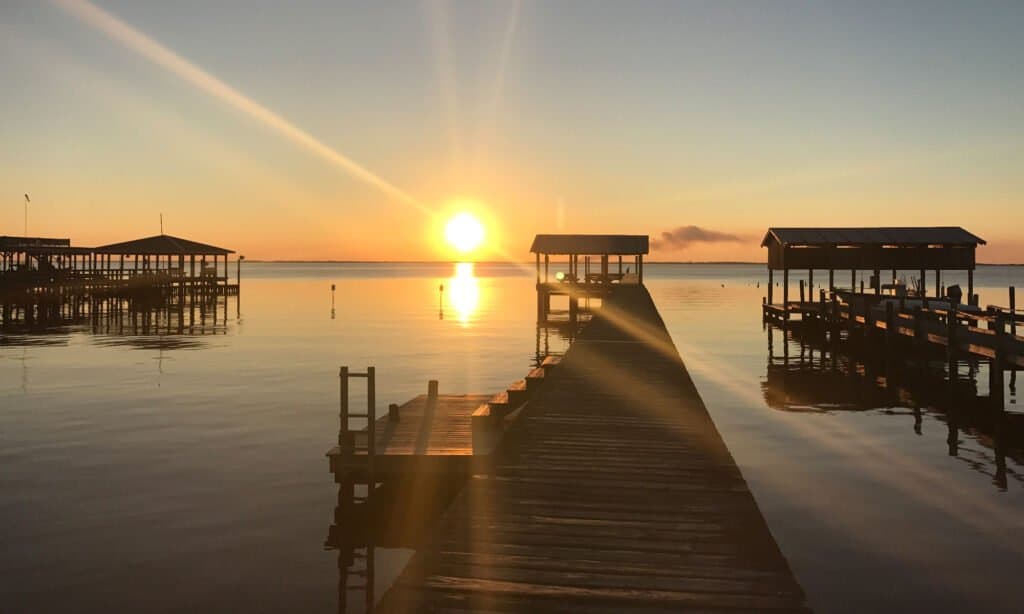
Calcasieu Lake is known for its albino pink dolphin named Pinky and is an excellent red drum and spotted
trout fishing
destination.
©iStock.com/Leslie Hemmis
- Surface Area: 49,150 acres
- Max Depth: N/A
- Camping/Overnight Available: No
- Boating/Docks Available: Yes
- Swimming Permitted: No
- Fishing Permitted: Yes
- Best For: Pinky the Dolphin, Red Drum & Spotted Sea Trout Fishing, Speckled Trout Capital of the World
Calcasieu Lake, locally known as Big Lake, is located in southwestern Louisiana close to Sabine Lake and the Texas border. The lake is known for a pink, albino dolphin that roams the waters named Pinky. The pink dolphin was first spotted in 2017 and remains a tourist attraction at the lake.
The lake is also known for great red drum and spotted trout fishing, even being called the “Speckled Trout Capital of the World.” Trout fishing from the shoreline is productive and deeper water opportunities are available through several boat launches around the lake. Crab, brown shrimp, and white shrimp are also common catches at Calcasieu Lake.
The area surrounding Lake Calcasieu Lake is home to over four hundred species of birds. Some of the species you might see flying around include laughing gull, green heron, black vulture, turkey vulture, Swainson’s hawk, eastern kingbird, purple martin, tree swallow, barn swallow, great-tailed grackle, summer tanager, northern cardinal, mourning dove, and ruby-throated hummingbird. Some other common species you will observe in the area and nearby Creole Nature Trail are wrens, chickadees, titmice, vireos, thrushes, warblers, and finches.
5. Catahoula Lake
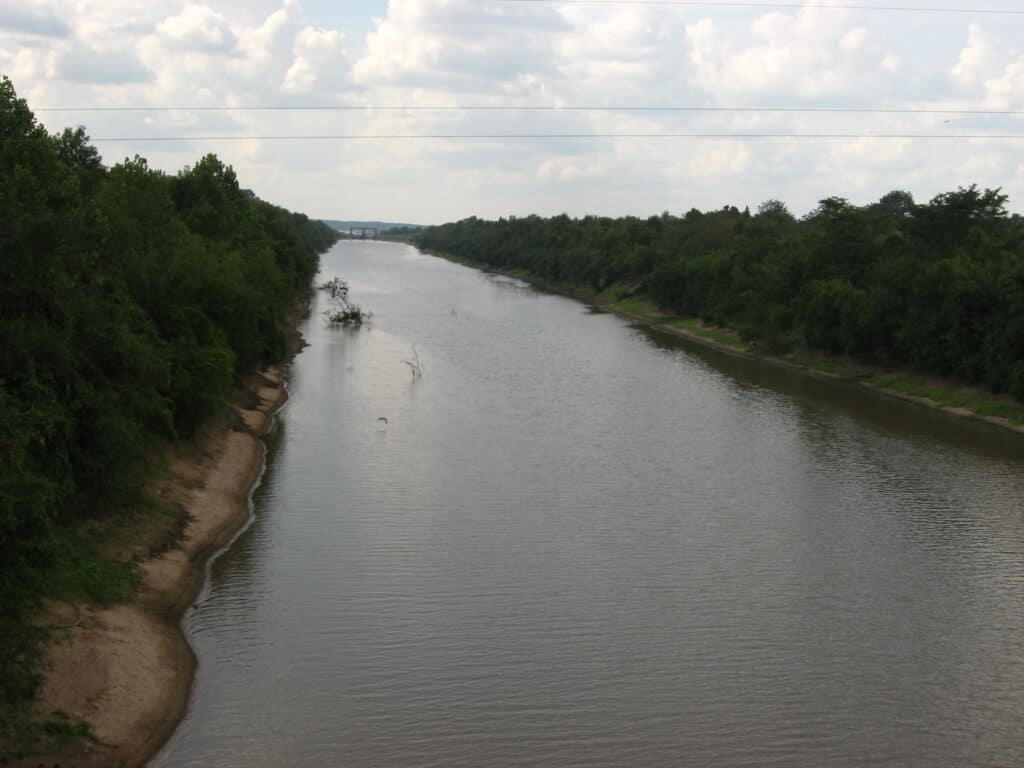
Catahoula Lake has a history of controversy regarding what type of body of water it is and who should own and access it.
©Ken Lund / flickr – License
- Surface Area: 30,000 acres
- Max Depth: 25 feet
- Camping/Overnight Available: Yes
- Boating/Docks Available: Yes
- Swimming Permitted: No
- Fishing Permitted: Yes
- Best For: Largest Natural Freshwater Lake In Louisiana, History of Controversy, Red Drum Fishing
Catahoula Lake is located in central-western Louisiana 30 miles northeast of Alexandria. It’s the largest natural freshwater lake in the state and is a shallow, poorly drained wetland categorized as the largest moist soil unit in Northern America. The lake has a history of controversy regarding what type of body of water it is exactly and who should own and be able to access the area.
Due to the current litigation surrounding the lake, it’s best to check the most current local regulations you can find for hunting. Anglers are currently able to access portions of the shoreline and the available boat launches. Common fish species reported at Catahoula Lake are largemouth bass, crappie, bluegill, catfish, and freshwater drum.
The nearby Catahoula National Wildlife Refuge is a prime spot for birding and wildlife enthusiasts. The diversity of the lake and surrounding area provides a home to many bird species including Cooper’s hawk, sharp-shinned hawk, spotted sandpiper, red-winged blackbird, mallard, American black duck, American cliff swallow, and downy woodpeckers. When hunting is permitted, the area is known to provide great opportunities to take home deer, squirrel, and duck.
6. Bayou D’Arbonne Lake
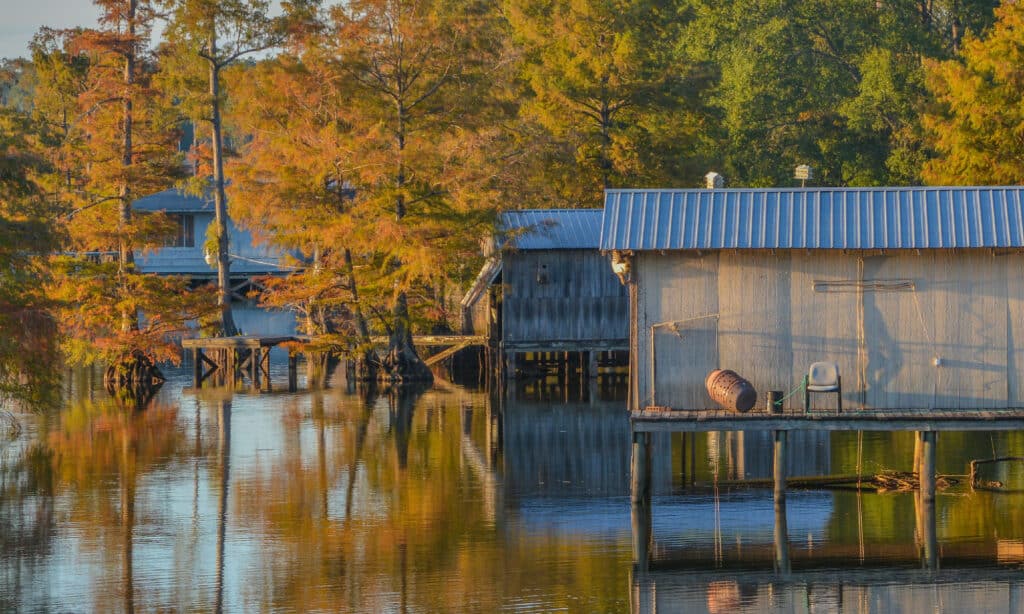
Bayou D’Arbonne Lake is one of the best crappie fishing lakes in the U.S.
©iStock.com/Norm Lane
- Surface Area: 15,250 acres
- Max Depth: 40 feet
- Camping/Overnight Available: Yes
- Boating/Docks Available: Yes
- Swimming Permitted: Yes
- Fishing Permitted: Yes
- Best For: One of the Best Crappie Fishing Lakes In the Country, Swimming, Canoeing, Kayaking, Wildlife Viewing
Bayou D’Arbonne Lake, located in north-central Louisiana, was formed in 1963 by the construction of a dam to provide water for industrial and agricultural purposes. The lake and surrounding area also provide recreational outdoor activities such as fishing, summer swimming, wildlife viewing, boating, and even golf. Anglers utilize the fishing piers and boat docks provided; nearby camping options including cabin rental are also available.
Crappie is the main attraction for anglers at Bayou D’Arbonne Lake; it’s known as one of the best lakes in the country for the species. Other commonly sought fish species in the lake are catfish, bass, perch, panfish, and bream. Although crappie is the prime target, there was a 15-pound lake-record bass pulled from the waters in 2000.
Nearby D’Arbonne State Park offers many amenities and activities including the White, Orange, Green, and Blue Trails for hiking, a visitors center, a lighted tennis court, a swimming pool, campsites, and playgrounds. Lake visitors explore the vast array of wildlife at Ouachita National Wildlife Refuge, on the lookout for the red-cockaded woodpecker, Louisiana black bear, deer, turkeys, alligators, beavers, and bald eagle.
7. Lac des Allemands
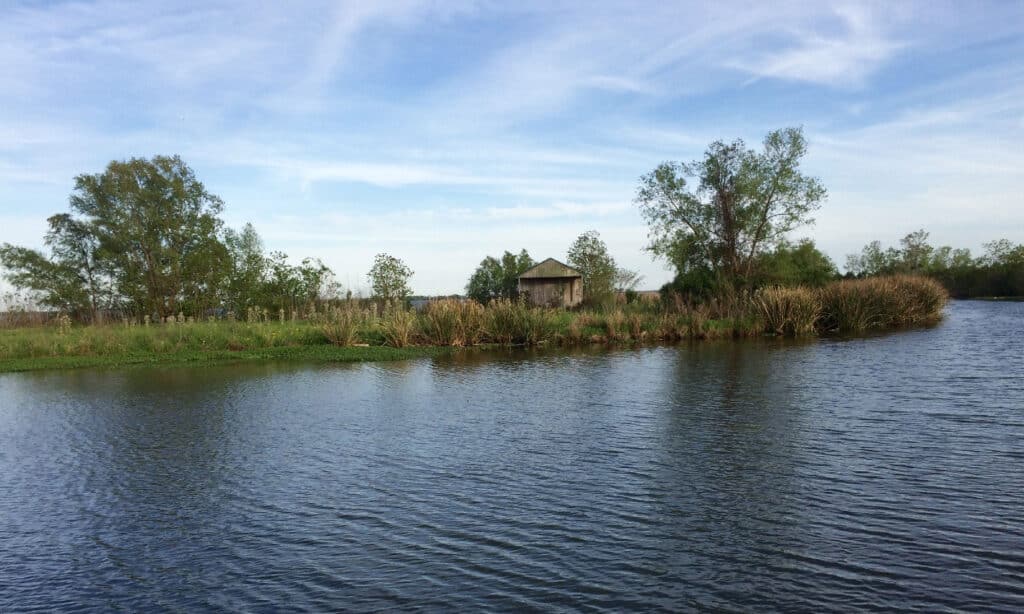
Lac des Allemands is 25 miles southwest of New Orleans and known to be the “Catfish Capital of the Universe.”
©Stanley Dry/Shutterstock.com
- Surface Area: 12,000 acres
- Max Depth: 10 feet
- Camping/Overnight Available: No
- Boating/Docks Available: Yes
- Swimming Permitted: Yes
- Fishing Permitted: Yes
- Best For: Catfish Capital of the Universe, Autumn Crappie Fishing
Lac des Allemands is located roughly 25 miles southwest of New Orleans in southeastern Louisiana. The lake’s name is French and translates to “Lake of the Germans” due to the number of German settlers that once lived in the area. Lac des Allemands is referred to as the “Catfish Capital of the Universe” for the abundance of the species that inhabit the waters.
The lake is made up of many canals, swamps, and bayous providing wetland habitats filled with fallen trees, grasses, stumps, and brush tops. A multitude of catfish swims the lake’s waters with eager anglers hoping to hook the next sixty-pound monster. Lac des Allemands is also home to many other types of fish including largemouth bass, spotted bass, bluegill, sunfish, and warmouth; crappie fishing is said to be best during autumn.
Lac des Allemands sports a 50-mile shoreline and several boat ramps for angling and boating enthusiasts. Wildlife and bird viewing opportunities are available with common species seen at Lac des Allemands being otters, raccoons, egrets, herons, alligators, bald eagles, alligators, and hawks.
8. Cross Lake
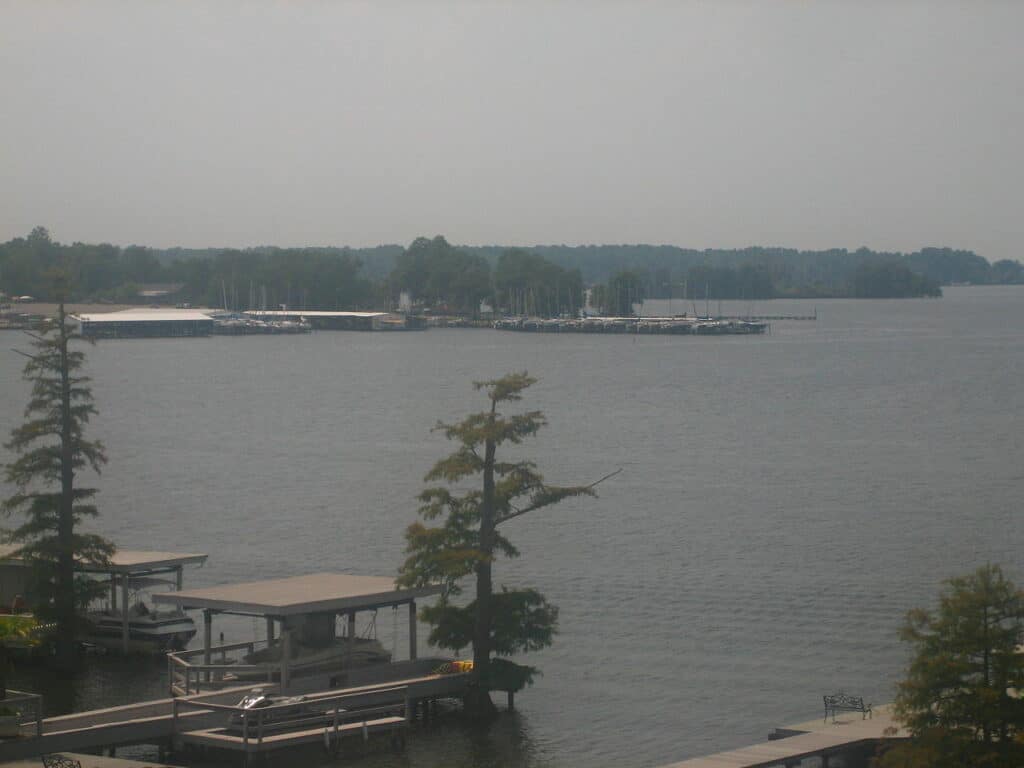
Cross Lake, just outside Shreveport, Louisiana is known for exceptional bass fishing; tournaments are held yearly.
©Billy Hathorn / Creative Commons – License
- Surface Area: 8,575 acres
- Max Depth: 27 feet
- Camping/Overnight Available: No
- Boating/Docks Available: Yes
- Swimming Permitted: Yes
- Fishing Permitted: Yes
- Best For: Bass Fishing, National Fishing Tournaments, Water Skiing, The Shreveport Yacht Club
Cross Lake was originally created to act as support for railroad lines and serve as a water supply for the city of Shreveport, Louisiana. Today the lake is a nationally recognized tournament-level bass fishing hot spot. Boating, watersports, and swimming are also very popular on Cross Lake, but remain cautious due to the alligator population.
Anglers know the lake for bass however many other species are regularly caught including crappie, catfish, white perch, bluegill, and red ear sunfish. With specific regulations for bass, be sure to check them in full detail; it’s a “slot lake.” The largemouth bass is the prime target at Cross Lake with tournaments happening regularly, so be sure to look ahead for dates!
There are two parks on Cross Lake, Ford Park and Richard Fleming Park, where visitors launch their boats. The 85-acre Ford Park boasts two ball fields, two tennis courts, a disc golf course, a walking trail, and a pier; both parks have picnic areas. Even more amenities in a relaxed and comfortable environment are found at The Shreveport Yacht Club.
9. Black Lake
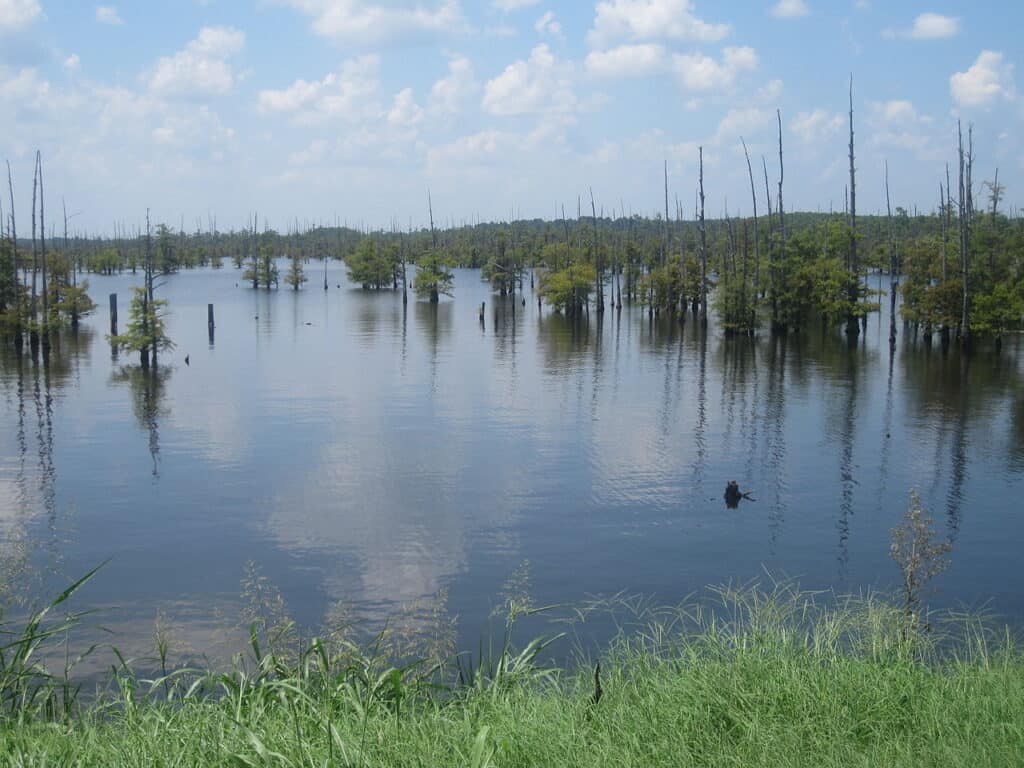
Black Lake has two names — part of it is referred to as Clear Lake — and offers great crappie and bream fishing.
©Billy Hathorn / CC BY-SA 3.0, via Wikimedia Commons – License
- Surface Area: 7,000 acres
- Max Depth: 18 feet
- Camping/Overnight Available: Yes
- Boating/Docks Available: Yes
- Swimming Permitted: N/A
- Fishing Permitted: Yes
- Best For: Bass & Black Crappie Fishing, Abundant and Colorful Bream, Good Hunting (with some restrictions)
Black Lake, also known as Clear Lake, is found in the area west of Highway 9. The area west of the bridge is Black Lake and the area below the bridge is Clear Lake. This separation and distinction create a unique habitat in which crappie thrives; making them extremely abundant in the lake.
Anglers know that Black Lake is shallow, so in colder weather, the fish will travel down the channel into Clear Lake. In addition to the great crappie fishing, anglers also target black bass, striped bass, catfish, smallmouth bass, largemouth bass, perch, rainbow trout, walleye, northern pike, bluegill, and sunfish. Black Lake is home to a noticeably abundant and colorful bream population.
The lake does provide some limited hunting options, however, the guidelines are very unique. There is no spring squirrel season and other stipulations and regulations are in place. Be sure to double-check before heading out.
10. Lake Pontchartrain — Largest Lake in Louisiana
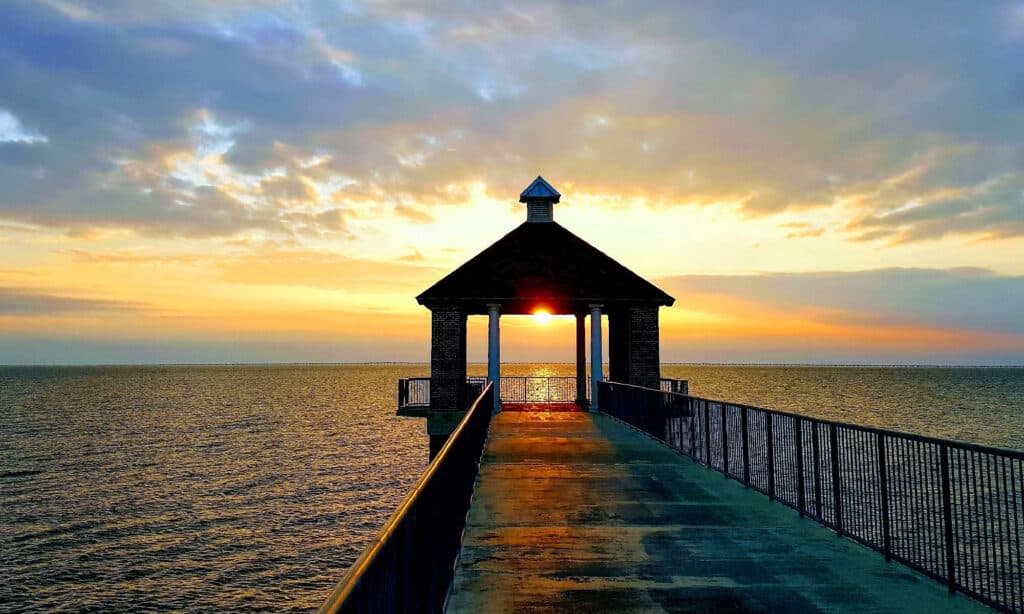
Lake Pontchartrain, the second-largest saltwater lake in the U.S., has the world’s longest continuous bridge.
©iStock.com/Idylle Images
- Surface Area: 403,000 acres
- Max Depth: 65 feet
- Camping/Overnight Available: Yes
- Boating/Docks Available: Yes
- Swimming Permitted: Yes
- Fishing Permitted: Yes
- Best For: World’s Longest Continuous Bridge, Second Largest Saltwater Lake In the United States, Catfish & Speckled Trout Fishing, Sheepshead Fishing
Lake Pontchartrain is a naturally formed tidal lagoon located in southeastern Louisiana that began taking shape thousands of years ago. The lake’s name comes from French Canadian explorer Pierre Le Moyne d’Iberville; the first European to discover the lake in 1699. It’s a brackish body of water with varying levels of salinity throughout the year; creating a diverse habitat for fish and other wildlife.
Anglers report the most popular fish species at Lake Pontchartrain as red drum, spotted seatrout, and Atlantic croaker. The lake’s waters are also home to flounder, shrimp, crab, and bull sharks. Lake Pontchartrain provides eight boat launches, several piers, and ample shoreline access for fishing and swimming.
The lake and surrounding wetland area are shelter to pelicans, eagles, ospreys, otters, manatees, gulls, terns, herons, egrets, rails, black skimmers, and many other types of birds and animals. Camping and overnight options surround the lake for full weekend adventures. Visitors should also take a drive on the longest continuous bridge over water in the world, spanning the second-largest saltwater lake in the United States.
11. Caddo Lake — Best Fishing Lake in Louisiana
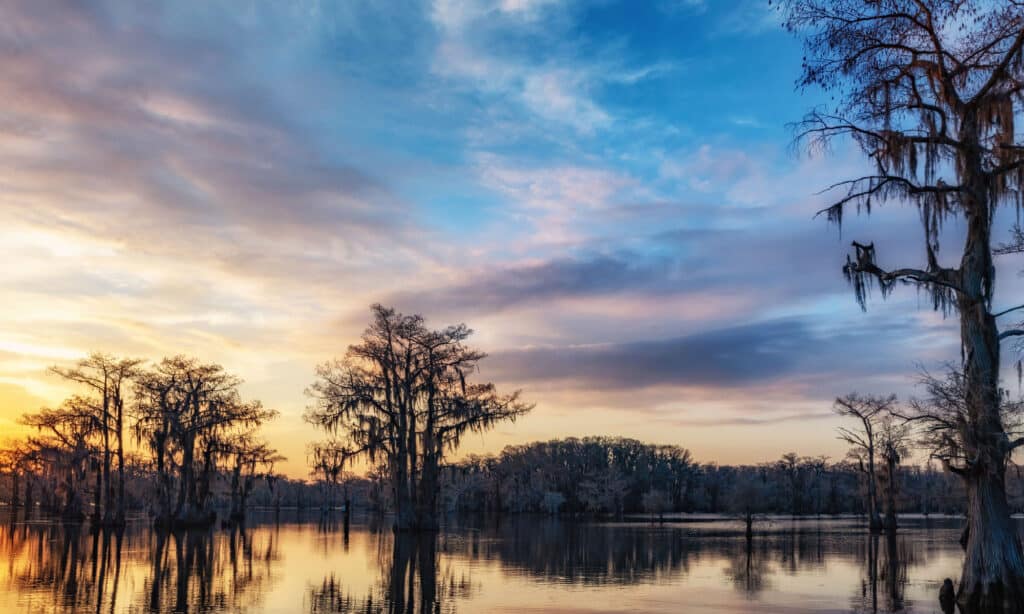
Caddo Lake, located in northwestern Louisiana on the Texas border, is known for excellent fishing and also has a rich historical background including Bigfoot sightings!
©iStock.com/westtexasfish
- Surface Area: 25,400 acres
- Max Depth: 20 feet
- Camping/Overnight Available: Yes
- Boating/Docks Available: Yes
- Swimming Permitted: Yes
- Fishing Permitted: Yes
- Best For: Abundance of Cypress Trees, Diverse Fish Species Population, World’s First Oil Platform Over Water in 1911, Texas Bigfoot
Caddo Lake is located in northwestern Louisiana on the Texas border. It’s an internationally protected wetland and one of the largest flooded cypress forests in the United States. Some speculation exists on the history of the lake’s creation with legend stating the 1811-12 New Madrid earthquakes were responsible and science pointing to the “Great Raft.” The raft was a 100-mile-long log jam very historically relevant to the lake and area.
The world’s first oil platform was built over Lake Caddo in 1911 in an effort to capitalize on the oil source discovered beneath the lake. The venture didn’t last long and oil drilling and harvesting soon halted and moved on. Later, ammunition processing caused further damage to the area, however, the environment has since been restored. Today, the lake is home to a wide range of wildlife species including owls, snakes, frogs, waterfowl, bobcats, river otters, beavers, eagles, and alligators.
There are more than 70 species of fish inhabiting the waters of Lake Caddo making it a highly sought-after destination for anglers. Largemouth bass is the primary species targeted however many other species inhabit the waters including crappie, catfish, chain pickerel, white bass, yellow bass, and sunfish. In addition to the diverse fish population, many other animals and birds call Lake Caddo home including snapping turtle, five-lined skink, American alligator, spiny soft-shelled turtle, eastern newt, greater white-fronted goose, snow goose, Ross’s Goose, Canadian goose, black-bellied whistling-duck, wood duck, gadwall, American wigeon, mallard, blue-winged teal, green-winged teal, northern shoveler, northern pintail, canvasback, redhead, and ring-necked duck.
Summary of 11 Lakes in Louisiana
Here’s a recap of the 11 Louisiana lakes that we took a look at.
| Number | Lake | Surface Area | Best For: |
|---|---|---|---|
| 1 | Toledo Bend Reservoir | 185,000 acres | Huge sunfish, largemouth bass, largest man-made lake In the South |
| 2 | Lake Borgne | 180,400 acres | Battle of Lake Borgne, spotted seatrout, diverse wildlife |
| 3 | Lake Maurepas | 59,310 acres | Pinky the dolphin, red drum, and spotted sea trout fishing, speckled trout capital of the world |
| 4 | Calcasieu Lake | 49,150 acres | Pinky the dolphin, red drum and spotted sea trout fishing, speckled trout capital of the world |
| 5 | Catahoula Lake | 30,000 acres | Largest natural freshwater lake In Louisiana, history of controversy, red drum fishing |
| 6 | Bayou D’Arbonne Lake | 15,250 acres | One of the best crappie fishing lakes In the U.S., swimming, canoeing, kayaking, wildlife viewing |
| 7 | Lac des Allemands | 12,000 acres | Catfish capital of the universe, autumn crappie fishing |
| 8 | Cross Lake | 8,575 acres | Bass fishing, national fishing tournaments, water skiing, The Shreveport Yacht Club |
| 9 | Black Lake | 7,000 acres | Bass and black crappie fishing, abundant bream, good hunting (with some restrictions) |
| 10 | Lake Pontchartrain | 403,000 acres | Largest lake in Louisiana; world’s longest continuous bridge, second-largest saltwater lake in the U.S., catfish and speckled trout fishing, sheepshead fishing |
| 11 | Caddo Lake | 25,400 acres | Best fishing lake in Louisiana; abundance of cypress trees, diverse fish species population, world’s first oil platform over water in 1911, Texas Bigfoot |
The photo featured at the top of this post is © Felix Mizioznikov/Shutterstock.com
FAQs (Frequently Asked Questions)
Where is the catfish capital of the world?
Lac Des Allemands is known as the “Catfish Capital of the World.”
Where can you find the longest continuous bridge over water in the world?
The Lake Pontchartrain Bridge is the longest continuous bridge over water in the world.
Thank you for reading! Have some feedback for us? Contact the AZ Animals editorial team.



